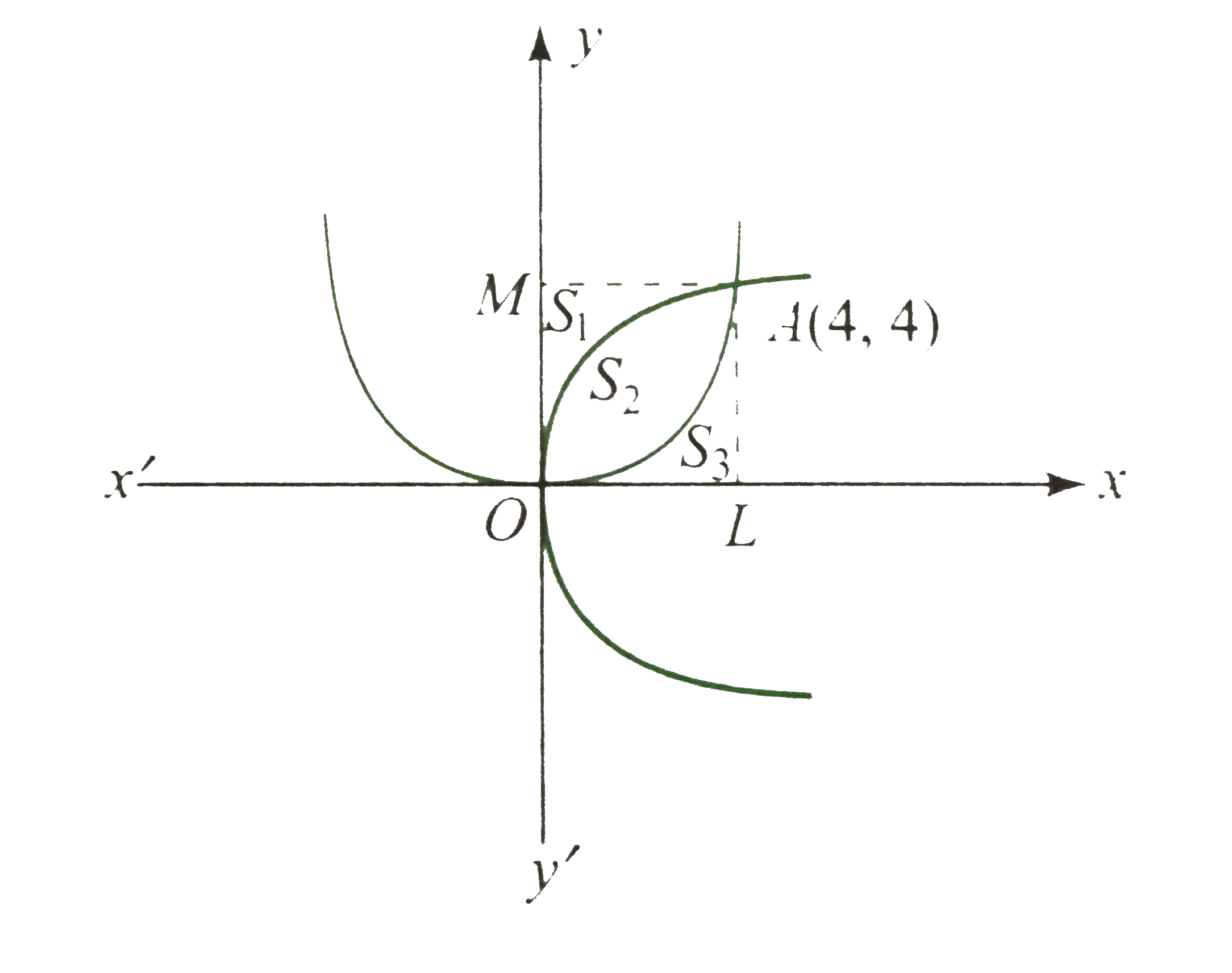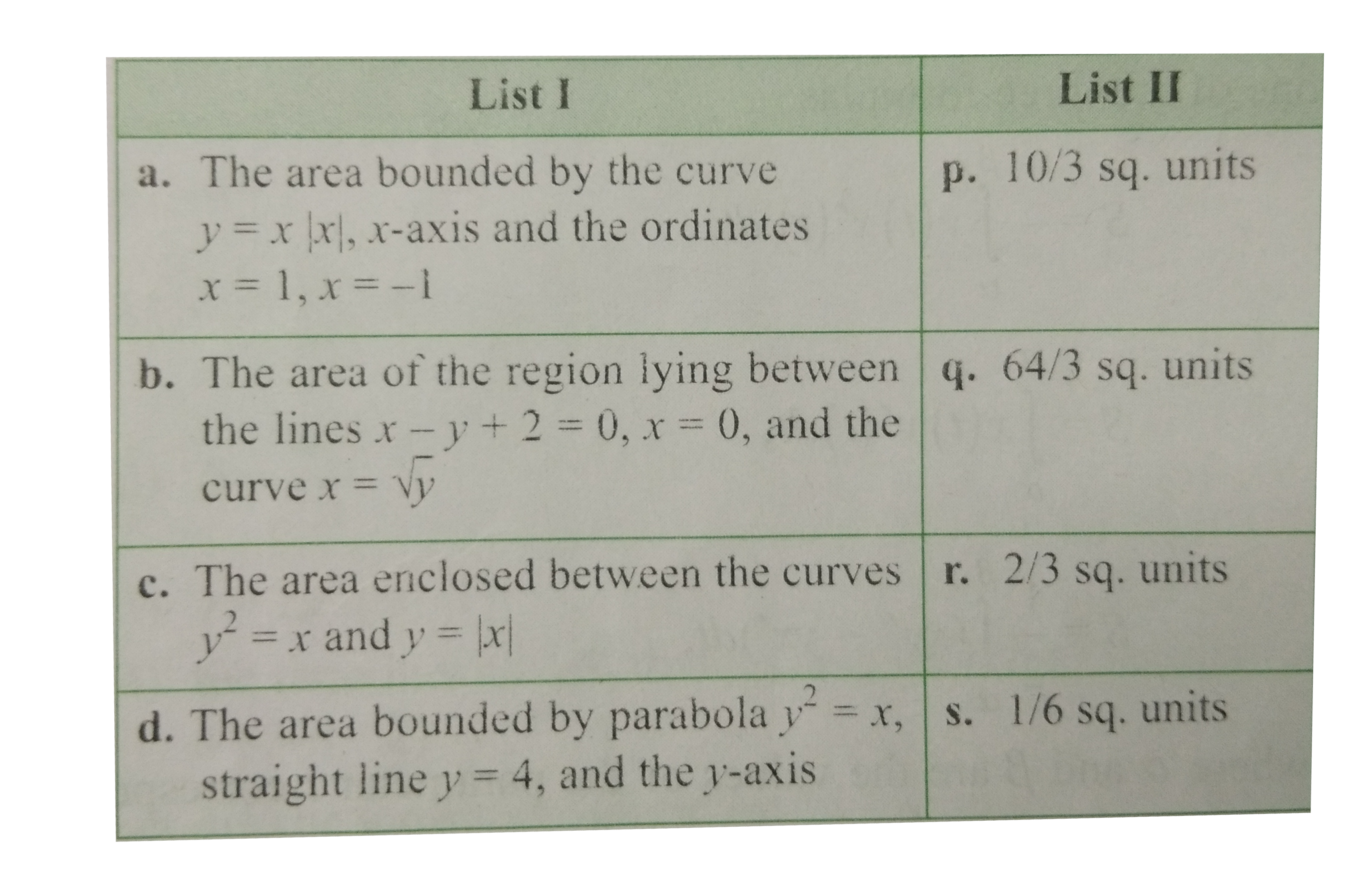The parabolas y2=4xandx2=4y divide the square region bounded by the lines x=4,y=4 and the coordinate axes. If S1,S2,S3 are the areas of these parts numbered from top to bottom, respectively, then S1:S2≡1:1 (b) S2:S3≡1:2 S1:S3≡1:1 (d) S1:(S1+S2)=1:2Solution in Bengali
S1:S2≡1:1
S2:S3≡1:2
S1:S3≡1:1
S1:(S1+S2)=1:2
The correct Answer is:A, C, D
y2=4xandx2=4y meet at O(0,0)andA(4,4).

Now, S3=∫40x24dx=14[x33]40=112[64−0]=163.
S2=∫402√xdx−S3=2[x3/23/2]−163
=43[8−0]−163=163.
And S1=4×4−(S2+S3)=16−(163+163)=163.
Hence, S1:S2:S3=1:1:1
Topper's Solved these Questions
- AREABOOK - CENGAGE PUBLICATIONCHAPTER - AREAEXERCISE - Linkded Comprehension Type
21 Videos
- AREABOOK - CENGAGE PUBLICATIONCHAPTER - AREAEXERCISE - Matrix Match Type
5 Videos
- AREABOOK - CENGAGE PUBLICATIONCHAPTER - AREAEXERCISE - Exercises - Single Correct Answer Type
40 Videos
- APPLICATIONS OF DERIVATIVESBOOK - CENGAGE PUBLICATIONCHAPTER - APPLICATIONS OF DERIVATIVESEXERCISE - Subjective Type
2 Videos
- BINOMIAL THEOREMBOOK - CENGAGE PUBLICATIONCHAPTER - BINOMIAL THEOREMEXERCISE - Comprehension
11 Videos
Similar Questions
Let Ar be the area of the region bounded between the curves y2=(e−kr)x(where k>0,r∈N) and the line y=mx(where m≠0), k and m are some constants
A1,A2,A3,… are in G.P. with common ratio
View SolutionMatch the following lists :

View SolutionArea enclosed by the curve y=f(x) defined parametrically as x=1−t21+t2,y=2t1+t2isequa<o πsq.units (b) π2sq.units 3π4sq.units (d) 3π2sq.units
View SolutionProve that for λ>1, the equation xlogx+x=λ has least one solution in [1,λ].
View SolutionConsider a G.P. with first term (1+x)n, |x|<1, common ratio 1+x2 and number of terms (n+1). Let 'S' be sum of all the terms of the G.P., then
The coefficient of xn is 'S' is
View SolutionIf S1=Σn,S2=Σn2,S3=Σn3,then the value of limn→∞S1(1+S38)S22 is equal to
View SolutionThe parabolas y2=4xandx2=4y divide the square region bounded by the lines x=4,y=4 and the coordinates axes. If S1,S2,S3 are the areas of these parts numbered from the top to bottom respectively,then-
View SolutionThe parabolas y2=4x and x2=4y divide the square region bounded by the lines x=4 , y=4 and the coordinate axes. If S1,S2,S3 are respectively the areas of these parts numbered from top to bottom , then S1:S2:S3 is :
View SolutionIf S1,S2andS3 be respectively the sum of n, 2n and 3n terms of a G.P., prove that S1(S2+S3)=(S1)2+(S2)2
View SolutionThe parabolas y2=4xandx2=4y divide the square region bounded by the lines x=4,y=4 and the coordinate axes. If S1,S2,S3 are the areas of these parts numbered from top to bottom, respectively, then S1:S2≡1:1 (b) S2:S3≡1:2 S1:S3≡1:1 (d) S1:(S1+S2)=1:2
View SolutionIf the sum of n,2n,3n terms of an AP are S1,S2,S3 respectively . Prove that S3=3(S2−S1)
View SolutionIf S1,S2,S3 be respectively the sums of n,2n,3n terms of a G.P., then prove that (S1)2+(S2)2=S1(S2+S3) .
View SolutionThe sum of n, 2n, 3n terms of an A.P. are S1,S2,S3 respectively. Prove that S3=3(S2−S1)
View SolutionIf S1,S2,S3 are the sums to n, 2n, 3n terms respectively for a GP then prove that S1,S2−S1,S3−S2 are in GP.
View SolutionIf S1,S2andS3 are respectively the sums of n, 2n and 3n terms of an AP.Prove that S3=3(S2−S1)
View Solutionਮੰਨ ਲਉ ਕਿਸੇ A.P. ਦੇ n, 2n, 3n ਪਦਾਂ ਦਾ ਜੋੜ ਕ੍ਰਮਵਾਰ S1, S2 ਅਤੇ S3, ਦਿਖਾਉ ਕਿ S3=3(S2−S1)
View Solution